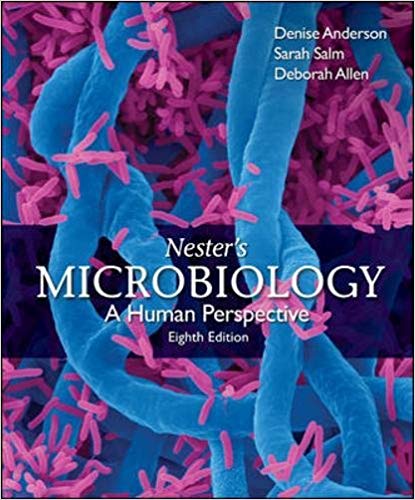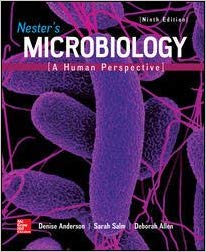Description
Test Bank For Nesters Microbiology A Human Perspective 8th Edition By Anderson Lecturer
Chapter 02
The Molecules of Life
Multiple Choice Questions
1. In addition to investigations with bacteria that led to him being considered the Father of Microbiology, Pasteur also
A. found that some molecules can exist as stereoisomers.
B. created aspartame.
C. separated organic acids using a microscope.
D. discovered polarized light.
E. found that some molecules can exist as stereoisomers AND separated organic acids using a microscope.
Bloom’s Level: 1. Remember
Learning Outcome: 02.01
Section: 02.01
Topic: Chemistry
2. The negatively charged component of the atom is the
A. proton.
B. nucleus.
C. neutron.
D. electron.
Bloom’s Level: 1. Remember
Learning Outcome: 02.01
Section: 02.01
Topic: Chemistry
3. The part of the atom that is most involved in chemical reactivity is the
A. proton.
B. neutron.
C. electron.
D. nucleus.
Bloom’s Level: 2. Understand
Learning Outcome: 02.01
Section: 02.01
Topic: Chemistry
4. Electrons
A. are found in areas outside the nucleus known as orbitals.
B. may gain or lose energy.
C. may move from one orbital to another.
D. are located farthest from the nucleus and have the least energy.
E. are found in areas outside the nucleus known as orbitals, may gain or lose energy, and may move from one orbital to another.
Bloom’s Level: 1. Remember
Learning Outcome: 02.01
Section: 02.01
Topic: Chemistry
Check All That Apply Questions
5.
The atomic number for an atom of a specific element is equal to (Check all that apply)
2-12-2013
__X__
the number of electrons in a single atom of that element._____ the number of electrons plus neutrons in a single atom of that element.
__X__ the number of protons in a single atom of that element.
_____ the number of neutrons and protons in a single atom of that element.
Bloom’s Level: 1. Remember
Learning Outcome: 02.01
Section: 02.01
Topic: Chemistry
Multiple Choice Questions
6. Sharing of electrons between 2 atoms forms a(n)
A. hydrogen bond.
B. ionic bond.
C. covalent bond.
D. strong bond.
E. covalent bond AND strong bond.
Bloom’s Level: 2. Understand
Learning Outcome: 02.03
Section: 02.02
Topic: Chemistry
7. If electrons are gained or lost in the formation of a bond, the bond is termed
A. covalent.
B. hydrogen.
C. ionic.
D. nonpolar.
Bloom’s Level: 2. Understand
Learning Outcome: 02.03
Section: 02.02
Topic: Chemistry
8. Charged atoms are termed
A. ions.
B. neutrons.
C. molecules.
D. polymers.
Bloom’s Level: 1. Remember
Learning Outcome: 02.03
Section: 02.02
Topic: Chemistry
9. Water
A. is a polar molecule.
B. is referred to as a universal solvent.
C. makes up over 70% (by wt.) of an organism.
D. is often a product or reactant in chemical reactions.
E. All of the choices are correct.
Bloom’s Level: 2. Understand
Learning Outcome: 02.05
Section: 02.03
Topic: Chemistry
10. pH
A. is a measure of the hydrogen ion concentration.
B. utilizes a scale from 5 to 8.
C. is a linear (not logarithmic) scale.
D.
is an abbreviation for “power of helium.”
E.
is a measure of the hydrogen ion concentration, utilizes a scale from 5 to 8, AND is a linear (not logarithmic) scale.
Bloom’s Level: 2. Understand
Learning Outcome: 02.06
Section: 02.03
Topic: Chemistry
11. The subunits (building blocks) of proteins are
A. nucleotides.
B. phospholipids.
C. amino acids.
D. carbohydrates.
Bloom’s Level: 1. Remember
Learning Outcome: 02.10
Section: 02.04
Topic: Chemistry
12. If the side chains of amino acids contain carboxyl (-COOH) groups, they
A. contribute a positive charge to the amino acid at pH 10.
B. contribute a negative charge to the amino acid at pH 10.
C. have no effect on the charge of the amino acid at pH 10.
D. are considered acidic amino acids.
E. contribute a negative charge to the amino acid at pH 10 AND are considered acidic amino acids.
Bloom’s Level: 3. Apply
Learning Outcome: 02.10
Section: 02.04
Topic: Chemistry





Be the first to review “Test Bank For Nesters Microbiology A Human Perspective 8th Edition By Anderson Lecturer”